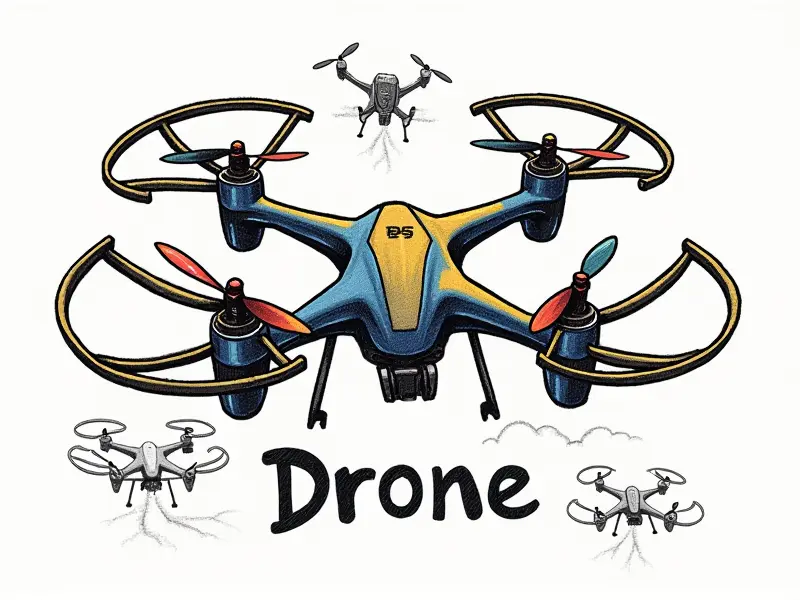How do FPV drones work?

FPV (First-Person View) drones are revolutionizing the world of aerial photography and racing, offering an immersive experience like no other. This article delves into the intricate workings of FPV drone technology to help you understand how these incredible machines operate.
How Does FPV Drone Technology Work?
FPV drone technology combines advanced hardware and software components to provide real-time video feeds, allowing pilots to control their drones with a first-person perspective. This section explores the core elements of an FPV system:
- Camera: Typically lightweight and high-definition, providing clear visuals.
- Transmitter (TX): Sends video signals from the drone to the ground station.
- Receiver (RX): Captures video signals sent by the transmitter.
- Goggles or Monitor: Displays real-time footage for pilots.
Inside FPV Drones: The Tech Explained
The inner workings of an FPV drone are fascinating. Here’s a breakdown of its key components:
- Flight Controller (FC): Manages all flight operations.
- Battery Management System (BMS): Monitors battery health and performance.
- Motor Controllers: Control the speed of motors for precise maneuvers.
- Propellers: Generate lift and thrust.
- Sensors: Include GPS, accelerometers, gyroscopes, and barometric pressure sensors.
Understanding FPV Drone Systems
An FPV drone system comprises several interconnected parts that work together to provide an immersive flight experience. Key components include:
- Video Transmission System: Ensures real-time video delivery.
- Pilot Control Station: Consists of a transmitter, receiver, and display device.
- Detection Systems: Include obstacle avoidance sensors for safety.
FPV Drone Basics: A Beginner's Guide
If you're new to FPV drones, here are some essential basics:
- Choosing the Right Gear: Opt for quality components that offer clear video and reliable performance.
- Familiarizing with Flight Controls: Learn how to control your drone effectively using a transmitter.
- Understanding Battery Requirements: FPV drones require high-capacity batteries for extended flight times.
What Makes FPV Drones Special?
FPV drones stand out due to their unique capabilities:
- Real-Time Video Feedback: Allows pilots to see what the drone sees, enhancing control and precision.
- High-Speed Maneuverability: FPV drones can perform acrobatic maneuvers at high speeds.
- Immersive Experience: Pilots feel like they are flying themselves, making it incredibly engaging.
FPV Drone Setup for Beginners
Setting up an FPV drone might seem daunting, but with the right approach, you can have your drone ready to fly in no time:
- Install Firmware and Software: Ensure your flight controller is updated.
- Configure Transmitter and Receiver: Pair them for seamless video transmission.
- Calibrate Sensors: Fine-tune your drone’s sensors for optimal performance.
How FPV Drones Provide Real-Time Video
The real-time video feed in FPV drones is a combination of high-quality cameras and advanced transmission technology:
- Camera Quality: High-definition cameras capture clear, detailed footage.
- Video Transmission: Signals are transmitted wirelessly to the ground station for real-time viewing.
- Latency Reduction: Low-latency transmission ensures smooth and responsive video feeds.
Mastering FPV Drone Controls and Flight Modes
Becoming proficient in controlling an FPV drone requires practice and understanding of its flight modes:
- Manual Mode: Provides full control over the drone’s movements.
- Acro Mode: Offers enhanced maneuverability for aerobatic flights.
- Gyro Lock Mode: Helps stabilize the drone during high-speed maneuvers.
Exploring First-Person View Drone Technology
The technology behind FPV drones involves sophisticated systems that enable a seamless flying experience:
- Battery Technology: High-capacity batteries ensure long flight times and reliable power delivery.
- Flight Dynamics: Advanced algorithms manage drone stability and control.
- Safety Features: Built-in safety measures like return-to-home and low-battery alerts protect the drone and pilot.
The Magic Behind FPV Racing Drones
FPV racing drones are designed for speed and agility:
- Lightweight Construction: Minimized weight allows for high-speed flights without compromising stability.
- Customizable Components: Pilots can tailor their drones to suit specific racing conditions.
- High-Performance Motors and ESCs: Deliver the power needed for rapid maneuvers.
FPV Drone Signal Transmission Explained
The signal transmission process is crucial in ensuring a seamless FPV experience:
- Video Encoder: Converts video signals into digital data for transmission.
- Airborne Transmitter: Sends the encoded signal from the drone to the ground station.
- Ground Receiver: Captures and decodes the transmitted signal, displaying it on a monitor or goggles.
Conclusion
FPV drones are more than just flying machines; they represent an exciting blend of technology, thrill, and precision. By understanding how these systems work, you can better appreciate their capabilities and enjoy the full potential of FPV drone technology. Whether you're a beginner or an experienced pilot, mastering FPV drones opens up endless possibilities in aerial exploration and entertainment.

